iOS学习之Map,定位,标记位置的使用
2015-06-19 10:12
483 查看
iOS学习之Map,定位,标记位置的使用
分类:iOS开发入门 2012-06-29 00:22
36681人阅读 评论(18)
收藏
举报
ioscllocationmanagerinterfacefloatlinker
目录(?)[+]
添加地图
定位到指定经纬度
添加标注大头针
定位到当前位置并获取当前经纬度
会遇到的问题
选择项目TARGETS 点加号添加两个framework
如何发送IOS模拟器经纬度
iOS上使用地图比Android要方便,只需要新建一个MKMapView,addSubView即可。这次要实现的效果如下:
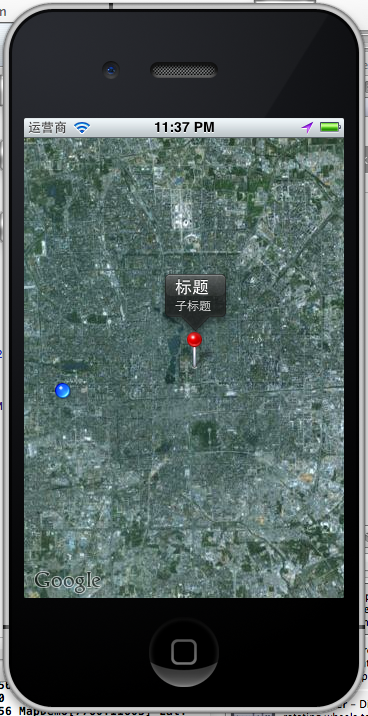
有标注(大头针),定位,地图。
1、添加地图
1.1 新一个Single View app ,选择默认项,创建后,在ViewController.h[cpp]
view plaincopyprint?
#import <UIKit/UIKit.h> #import <MapKit/MapKit.h> #import <CoreLocation/CoreLocation.h> @interface ViewController : UIViewController <MKMapViewDelegate, CLLocationManagerDelegate> { MKMapView *map; CLLocationManager *locationManager; } @end
#import <UIKit/UIKit.h>
#import <MapKit/MapKit.h>
#import <CoreLocation/CoreLocation.h>
@interface ViewController : UIViewController
<MKMapViewDelegate, CLLocationManagerDelegate> {
MKMapView *map;
CLLocationManager *locationManager;
}
@end1.2在ViewController.m中添加
[cpp]
view plaincopyprint?
- (void)viewDidLoad
{
map = [[MKMapView alloc] initWithFrame:[self.view bounds]];
map.showsUserLocation = YES;
map.mapType = MKMapTypeSatellite;
[self.view addSubview:map];
[super viewDidLoad];
// Do any additional setup after loading the view, typically from a nib.
}
- (void)viewDidLoad
{
map = [[MKMapView alloc] initWithFrame:[self.view bounds]];
map.showsUserLocation = YES;
map.mapType = MKMapTypeSatellite;
[self.view addSubview:map];
[super viewDidLoad];
// Do any additional setup after loading the view, typically from a nib.
}运行:
OMG,看到的是世界地图。怎么定位到指定的位置呢?比如定位回来伟大的祖国首都?
这里map.mapType =MKMapTypeSatellite;我用到是卫星地图,可以使用标准的地图,
map.mapType =MKMapTypeStandard;

注意,如果此时你编译有错误,请拉到博客最后查看 :5、 遇到的问题
2、定位到指定经纬度
[cpp]view plaincopyprint?
CLLocationCoordinate2D coords = CLLocationCoordinate2DMake(39.915352,116.397105); float zoomLevel = 0.02; MKCoordinateRegion region = MKCoordinateRegionMake(coords, MKCoordinateSpanMake(zoomLevel, zoomLevel)); [map setRegion:[map regionThatFits:region] animated:YES];
CLLocationCoordinate2D coords = CLLocationCoordinate2DMake(39.915352,116.397105); float zoomLevel = 0.02; MKCoordinateRegion region = MKCoordinateRegionMake(coords, MKCoordinateSpanMake(zoomLevel, zoomLevel)); [map setRegion:[map regionThatFits:region] animated:YES];
这样,就我们就定位的了故宫了。

3、添加标注大头针
3.1 新建一个标注类:CustomAnnotation按Command+N,继承NSObject。在CustomAnnotation.h 和CustomAnnotation.m文件添加如下代码:
[cpp]
view plaincopyprint?
#import <Foundation/Foundation.h>
#import <MapKit/MapKit.h>
@interface CustomAnnotation : NSObject
<MKAnnotation>
{
CLLocationCoordinate2D coordinate;
NSString *title;
NSString *subtitle;
}
-(id) initWithCoordinate:(CLLocationCoordinate2D) coords;
@property (nonatomic, readonly) CLLocationCoordinate2D coordinate;
@property (nonatomic, retain) NSString *title;
@property (nonatomic, retain) NSString *subtitle;
@end
#import <Foundation/Foundation.h>
#import <MapKit/MapKit.h>
@interface CustomAnnotation : NSObject
<MKAnnotation>
{
CLLocationCoordinate2D coordinate;
NSString *title;
NSString *subtitle;
}
-(id) initWithCoordinate:(CLLocationCoordinate2D) coords;
@property (nonatomic, readonly) CLLocationCoordinate2D coordinate;
@property (nonatomic, retain) NSString *title;
@property (nonatomic, retain) NSString *subtitle;
@end[cpp]
view plaincopyprint?
#import "CustomAnnotation.h" @implementation CustomAnnotation @synthesize coordinate, title, subtitle; -(id) initWithCoordinate:(CLLocationCoordinate2D) coords { if (self = [super init]) { coordinate = coords; } return self; } @end
#import "CustomAnnotation.h"
@implementation CustomAnnotation
@synthesize coordinate, title, subtitle;
-(id) initWithCoordinate:(CLLocationCoordinate2D) coords
{
if (self = [super init]) {
coordinate = coords;
}
return self;
}
@end3.1 使用大头针,
新建个方法添加大头针的
[cpp]
view plaincopyprint?
-(void)createAnnotationWithCoords:(CLLocationCoordinate2D) coords { CustomAnnotation *annotation = [[CustomAnnotation alloc] initWithCoordinate: coords]; annotation.title = @"标题"; annotation.subtitle = @"子标题"; [map addAnnotation:annotation]; }
-(void)createAnnotationWithCoords:(CLLocationCoordinate2D) coords {
CustomAnnotation *annotation = [[CustomAnnotation alloc] initWithCoordinate:
coords];
annotation.title = @"标题";
annotation.subtitle = @"子标题";
[map addAnnotation:annotation];
}调用
[cpp]
view plaincopyprint?
CLLocationCoordinate2D coords = CLLocationCoordinate2DMake(39.915352,116.397105); float zoomLevel = 0.02; MKCoordinateRegion region = MKCoordinateRegionMake(coords, MKCoordinateSpanMake(zoomLevel, zoomLevel)); [map setRegion:[map regionThatFits:region] animated:YES];
[self createAnnotationWithCoords:coords];
CLLocationCoordinate2D coords = CLLocationCoordinate2DMake(39.915352,116.397105); float zoomLevel = 0.02; MKCoordinateRegion region = MKCoordinateRegionMake(coords, MKCoordinateSpanMake(zoomLevel, zoomLevel)); [map setRegion:[map regionThatFits:region] animated:YES];这样我们就把大头针定位在故宫了
[self createAnnotationWithCoords:coords];
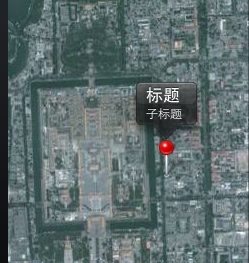
4、定位到当前位置并获取当前经纬度
前面我们已经添加了locationManager,现在在DidViewLoad里直接调用[cpp]
view plaincopyprint?
locationManager = [[CLLocationManager alloc] init]; locationManager.delegate = self; [locationManager startUpdatingLocation];
locationManager = [[CLLocationManager alloc] init]; locationManager.delegate = self; [locationManager startUpdatingLocation];
实现协议方法收到定位成功后的经纬度
[cpp]
view plaincopyprint?
- (void)locationManager:(CLLocationManager *)manager didUpdateToLocation:(CLLocation *)newLocation fromLocation:(CLLocation *)oldLocation { [locationManager stopUpdatingLocation]; NSString *strLat = [NSString stringWithFormat:@"%.4f",newLocation.coordinate.latitude]; NSString *strLng = [NSString stringWithFormat:@"%.4f",newLocation.coordinate.longitude]; NSLog(@"Lat: %@ Lng: %@", strLat, strLng); } - (void)locationManager:(CLLocationManager *)manager didFailWithError:(NSError *)error { NSLog(@"locError:%@", error); }
- (void)locationManager:(CLLocationManager *)manager didUpdateToLocation:(CLLocation *)newLocation fromLocation:(CLLocation *)oldLocation {
[locationManager stopUpdatingLocation];
NSString *strLat = [NSString stringWithFormat:@"%.4f",newLocation.coordinate.latitude];
NSString *strLng = [NSString stringWithFormat:@"%.4f",newLocation.coordinate.longitude];
NSLog(@"Lat: %@ Lng: %@", strLat, strLng);
}
- (void)locationManager:(CLLocationManager *)manager didFailWithError:(NSError *)error {
NSLog(@"locError:%@", error);
}
运行,允许获取当前位置,打印log
[cpp]
view plaincopyprint?
2012-06-28 23:58:32.237 MapDemo[8202:11603] Lat: 39.9011 Lng: 116.3000
2012-06-28 23:58:32.237 MapDemo[8202:11603] Lat: 39.9011 Lng: 116.3000如果不允许:打印出错误日志
[cpp]
view plaincopyprint?
2012-06-28 23:25:03.109 MapDemo[7531:11603] locError:Error Domain=kCLErrorDomain Code=1 "The operation couldn’t be completed. (kCLErrorDomain error 1.)"
2012-06-28 23:25:03.109 MapDemo[7531:11603] locError:Error Domain=kCLErrorDomain Code=1 "The operation couldn’t be completed. (kCLErrorDomain error 1.)"
定位后,移动到当前位置:
[cpp]
view plaincopyprint?
- (void)locationManager:(CLLocationManager *)manager didUpdateToLocation:(CLLocation *)newLocation fromLocation:(CLLocation *)oldLocation { [locationManager stopUpdatingLocation]; NSString *strLat = [NSString stringWithFormat:@"%.4f",newLocation.coordinate.latitude]; NSString *strLng = [NSString stringWithFormat:@"%.4f",newLocation.coordinate.longitude]; NSLog(@"Lat: %@ Lng: %@", strLat, strLng); CLLocationCoordinate2D coords = CLLocationCoordinate2DMake(newLocation.coordinate.latitude,newLocation.coordinate.longitude); float zoomLevel = 0.02; MKCoordinateRegion region = MKCoordinateRegionMake(coords,MKCoordinateSpanMake(zoomLevel, zoomLevel)); [map setRegion:[map regionThatFits:region] animated:YES]; }
- (void)locationManager:(CLLocationManager *)manager didUpdateToLocation:(CLLocation *)newLocation fromLocation:(CLLocation *)oldLocation {
[locationManager stopUpdatingLocation];
NSString *strLat = [NSString stringWithFormat:@"%.4f",newLocation.coordinate.latitude];
NSString *strLng = [NSString stringWithFormat:@"%.4f",newLocation.coordinate.longitude];
NSLog(@"Lat: %@ Lng: %@", strLat, strLng);
CLLocationCoordinate2D coords = CLLocationCoordinate2DMake(newLocation.coordinate.latitude,newLocation.coordinate.longitude);
float zoomLevel = 0.02;
MKCoordinateRegion region = MKCoordinateRegionMake(coords,MKCoordinateSpanMake(zoomLevel, zoomLevel));
[map setRegion:[map regionThatFits:region] animated:YES];
}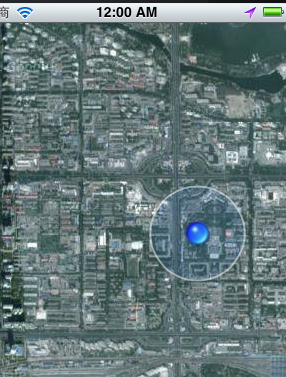
定位到了当前位置。
5、会遇到的问题:
运行是发现了编译错误:Undefined symbols for architecture i386:
"_CLLocationCoordinate2DMake", referenced from:
-[ViewController viewDidLoad] in ViewController.o
-[ViewController locationManager:didUpdateToLocation:fromLocation:] in ViewController.o
"_OBJC_CLASS_$_MKMapView", referenced from:
objc-class-ref in ViewController.o
"_OBJC_CLASS_$_CLLocationManager", referenced from:
objc-class-ref in ViewController.o
ld: symbol(s) not found for architecture i386
clang: error: linker command failed with exit code 1 (use -v to see invocation)
这是为什么呢?没有添加对应的FrameWork。我使用的是4.3.2版本的XCode,添加方法如下:
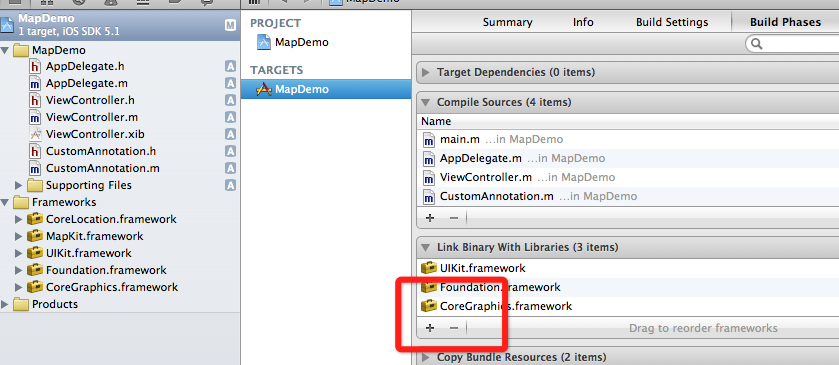
选择项目,TARGETS ,点加号,添加两个framework
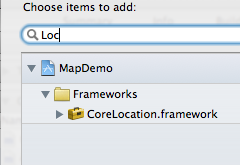
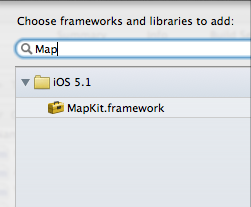
就好了。
如何发送IOS模拟器经纬度?
5.0以上的模拟器才能用这个功能,打开模拟: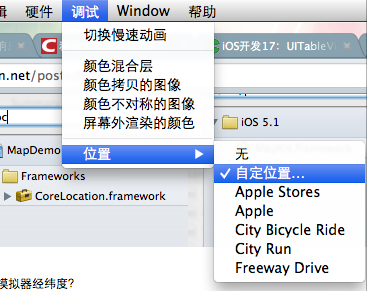
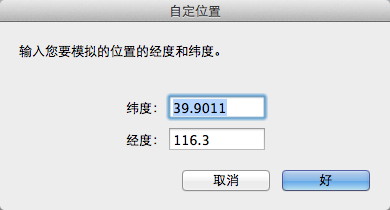
这样就能发送模拟的当前位置了。
例子代码:http://download.csdn.net/detail/totogo2010/4400001点击打开链接
https://github.com/schelling/YcDemo/tree/master/MapDemo
著作权声明:本文由http://blog.csdn.net/totogo2010/原创,欢迎转载分享。请尊重作者劳动,转载时保留该声明和作者博客链接,谢谢!
相关文章推荐
- IOS之地图和定位应用开发
- iOS的影片播放 MediaPlayer 和 AVPlayer
- iOS MD5加密算法
- 使用Xcode和Instruments调试解决iOS内存泄露
- iOS 图片实现马赛克效果
- ios开发之使用phonegap调用本地相机
- 【iOS多线程】Mac&iOS之多线程
- IOS Socket使用大全
- iOS项目开发之Socket编程
- iOS 中KVC、KVO、NSNotification、delegate 总结及区别
- 10步成为专业iOS开发者——从零起步
- AudioServicesPlaySystemSound音频服务—IOS开发
- AVAudioPlayer音频播放器—IOS开发
- iOS开发之AVAudioPlayer 音频播放
- iOS 基础复习
- 源码推荐(6.19):趣味下拉刷新-Replace-iOS,单元格常用的滑动选项-DRCellSlideGestureR
- IOS 实现控制器翻页的简单解决方法
- ios7与ios8系统版本不同出现的问题积累
- IOS 使用SDWebImage清除图片缓存
- IOS 获取触摸点的坐标位置
